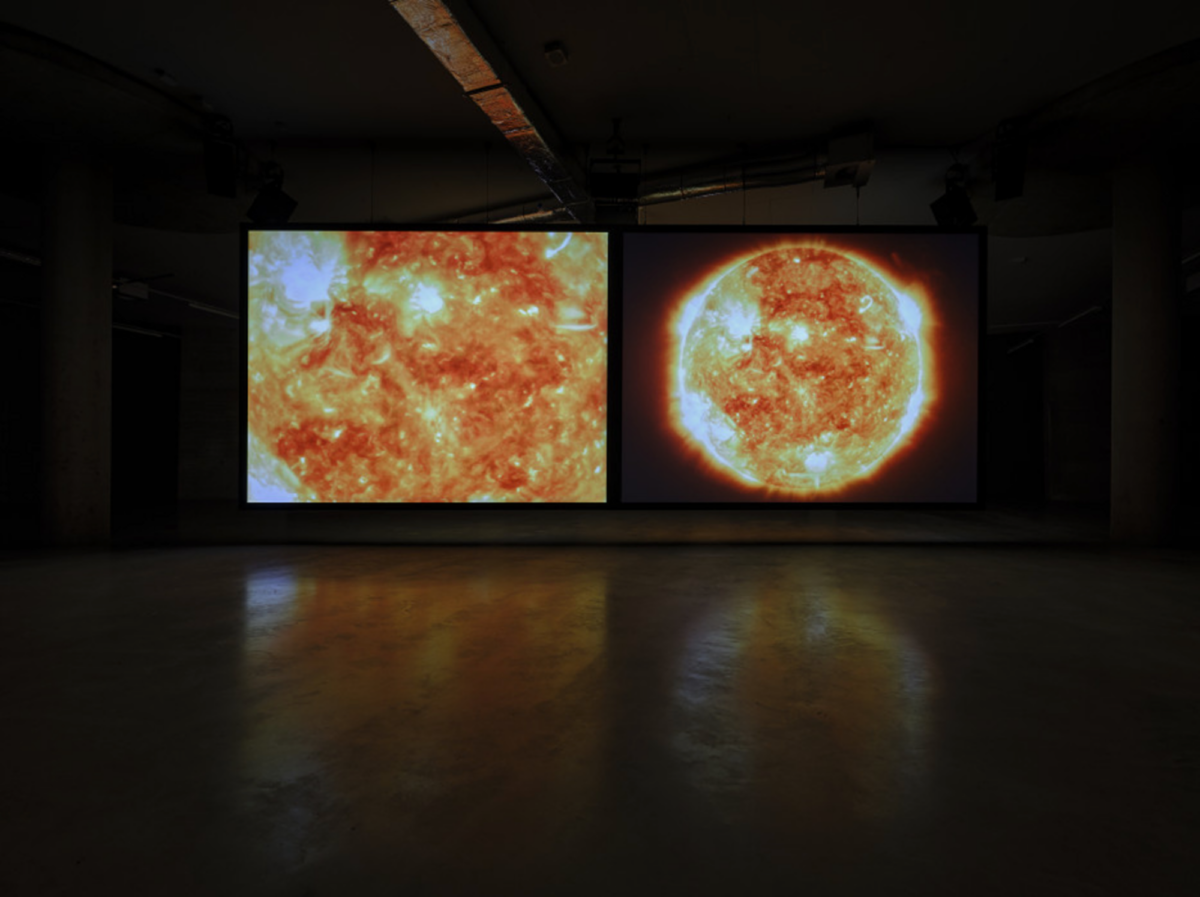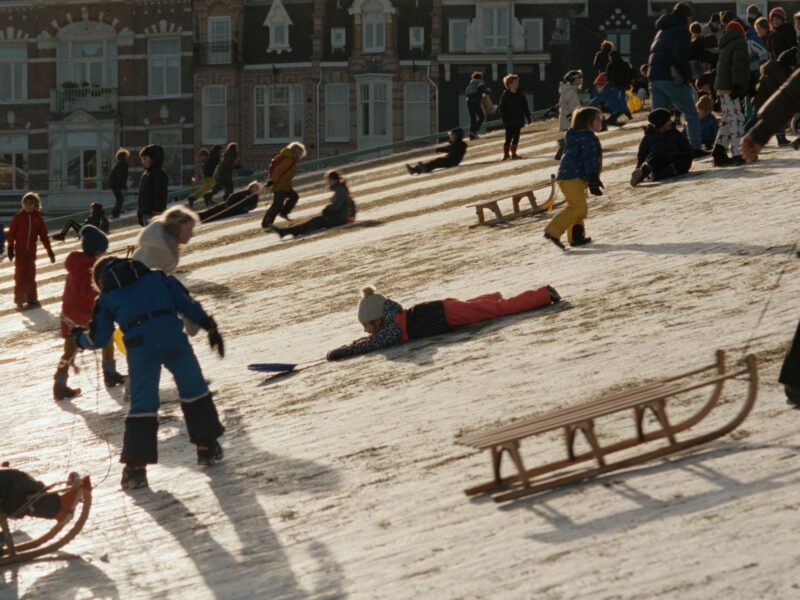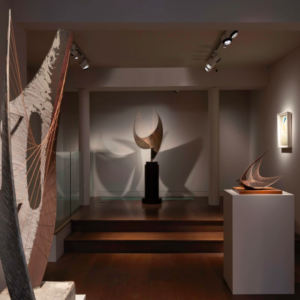
This fall, Dia opens an exhibition of work by Steve McQueen at Dia Chelsea. The presentation centers on Sunshine State (2022), a two-channel, dual-sided video projection that enlists a story about McQueen’s father and excerpts from The Jazz Singer (1927) to examine notions of identity and racial stereotypes. In tandem with Sunshine State, McQueen has elected to revisit one of his earliest works, Exodus (1992–97), a film that follows two West Indian men through the streets of London, and created Bounty (2024), a new set of photographs taken in Grenada, his parents’ place of origin. Steve McQueen will be on view from September 20, 2024, until summer 2025. Admission to Dia Chelsea is always free.
A concurrent Steve McQueen exhibition is on view at Dia Beacon through May 2025, featuring Bass (2024), a work co-commissioned by Dia and Laurenz Foundation, Schaulager Basel. The two exhibitions by McQueen mark Dia’s 50th year and highlight the institution’s decades-long commitment to ambitious, single-artist presentations.
For more than 30 years, McQueen has continually investigated the possibilities inherent in film—as a material, documentary tool, and storytelling medium—resulting in work that is formally inventive and politically pointed. Often delving into power relations, McQueen’s films and videos capture the experience of living both within and in opposition to hierarchical structures, critically examining current social issues by drawing on the histories of cinema and video art and the reduced formal vocabulary of Minimalism.
“With the opening of this exhibition in Chelsea, alongside the ongoing presentation of Bass at Dia Beacon, we are thrilled to offer our audiences the opportunity to explore Steve McQueen’s multifaceted practice across multiple sites. While Bass pares down film to its essential qualities—sound and light—to evoke the trauma of displacement, the video and photographic works on view at Dia Chelsea take a different route to investigate histories both personal to the artist and shared with the Black diaspora,” said Jessica Morgan, Dia’s Nathalie De Gunzburg Director.
A configuration of projections on both sides of two large, adjacent screens, Sunshine State encourages visitors to move through the space and view it from different vantage points. Opening with footage of a burning sun, the work unfurls clips from the musical drama The Jazz Singer, the first “talkie” in the history of cinema that starred the singer Al Jolson. In a voice-over, McQueen recounts a poignant story that his late father relayed on his deathbed about a personal experience of violence in Florida, giving the work its title. Originally commissioned by the International Film Festival Rotterdam, Sunshine State’s Chelsea presentation marks its debut on the East Coast of the United States, throwing its eponymous connection to Florida into sharp relief.
In the adjacent gallery, the artist presents Exodus, a monitor-based video. While walking in a busy London street with a Super 8 mm camera, the artist began filming two men from the West Indies as they carry potted palm trees, gesturing toward metaphors of African diasporic migration. Alongside the early work is Bounty, a new set of photographs documenting flowers found in Grenada, for which McQueen journeyed to the island in summer 2024. In the artist’s words, the photographs consider how, over centuries of colonial rule, “what has been a constant in the landscape [of Grenada] has been the beauty of flowers. These plants have been a thing of wonder within a landscape which has been traumatized by colonialism and slavery.”
“In his gallery installations, as well as his feature films, McQueen tells stories based on investigations into histories, often repressed or forgotten, probing the human condition with all its contradictions and vulnerabilities. McQueen consistently conflates the past and present, as in the three works at Dia Chelsea and in Bass at Dia Beacon which come together to form a loose series of journeys to both real and remembered places. Whatever medium McQueen employs, the viewer’s relationship to the work is paramount, thus implicating us in the inescapable now,” said Donna De Salvo, Dia’s senior adjunct curator.
Steve McQueen is curated by Donna De Salvo, senior adjunct curator, special projects, with Emily Markert, curatorial assistant.
All exhibitions at Dia are made possible by the Economou Exhibition Fund.
Dia’s two-part presentation of Steve McQueen is made possible by major support from the Ford Foundation, Horace W. Goldsmith Foundation, and Brenda R. Potter. Significant support is provided by the Brown Foundation, Inc. of Houston; Marguerite Hoffman; Michelle and Bill Pohlad; and Salon Art + Design. Generous support is provided by Dia’s Director’s Council, and additional support by Sarah Arison; Ivor Braka Limited, London; Dorothy Lichtenstein; Tristin and Martin Mannion; Sotheby’s; Visiolite; and those who wish to remain anonymous.
A concurrent presentation of McQueen’s Bass is on view at Dia Beacon, New York, May 12, 2024 – May 2025.
The publication accompanying Bass was made possible by the Laurenz Foundation. Additional support provided by Marian Goodman Gallery, New York, Paris, and Los Angeles, and Thomas Dane Gallery, London and Naples.
About the artist
Steve McQueen was born in London in 1969. Surveys of his work have been held at the Art Institute of Chicago and Laurenz Foundation, Schaulager Basel (2012–13); Tate Modern, London (2020); and Pirelli HangarBicocca, Milan (2022). Recent solo presentations include those at the Whitney Museum of American Art, New York (2016); the Art Institute of Chicago (2017); Museum of Modern Art, New York (2017); Pérez Art Museum, Miami (2017); Whitworth Art Gallery, Manchester (2017); Institute of Contemporary Art, Boston (2017–18); Tate Britain, London (2019–21); and Serpentine Gallery, London (2023). McQueen has participated in Documenta X (1997) and XI (2002), as well as the Venice Biennale (2003, 2007, 2013, and 2015), representing Great Britain in 2009. He is the recipient of numerous awards, including the Turner Prize (1999); W. E. B. Du Bois Medal, Harvard University (2014); and Johannes Vermeer Award (2016). He was declared Officer of the Most Excellent Order of the British Empire in 2002, Commander of the Most Excellent Order of the British Empire in 2011, and Knight Commander of the Most Excellent Order of the British Empire in 2020.
McQueen directed the feature films Hunger (2008), Shame (2011), 12 Years a Slave (2014), and Widows (2018), as well as the series Small Axe (2020), an anthology of five films shown on the BBC and Amazon; and Uprising (2021), a three-part documentary series for the BBC. His documentary, Occupied City (2023) is based on the book Atlas van een bezette stad: Amsterdam 1940–1945 (Atlas of an Occupied City: Amsterdam 1940–1945, 2019) by Bianca Stigter. McQueen won the Caméra d’Or at the Cannes Film Festival for Hunger in 2008 and an Oscar for Best Motion Picture for 12 Years a Slave in 2014. McQueen lives in Amsterdam and London.
About Dia Art Foundation
Taking its name from the Greek word meaning “through,” Dia was established in 1974 with the mission to serve as a conduit for artists to realize ambitious new projects, unmediated by overt interpretation and uncurbed by the limitations of more traditional museums and galleries. Dia’s programming fosters contemplative and sustained consideration of a single artist’s body of work and its collection is distinguished by the deep and longstanding relationships that the nonprofit has cultivated with artists whose work came to prominence particularly in the 1960s and ’70s.
In addition to Dia Beacon, Dia Bridgehampton, and Dia Chelsea, Dia maintains and operates a constellation of commissions, long-term installations, and site-specific projects, notably focused on Land art, nationally and internationally. These include:
Walter De Maria’s The New York Earth Room (1977) and The Broken Kilometer (1979), Max Neuhaus’s Times Square (1977), and Joseph Beuys’s 7000 Eichen (7000 Oaks, inaugurated in 1982 and ongoing), all located in New York, De Maria’s The Lightning Field (1977), in western New Mexico,Robert Smithson’s Spiral Jetty (1970), in the Great Salt Lake, Utah, Nancy Holt’s Sun Tunnels (1973–76), in the Great Basin Desert, Utah & De Maria’s The Vertical Earth Kilometer (1977), in Kassel, Germany Cameron Rowland’s Depreciation (2018) Edisto Island, South Carolina.







